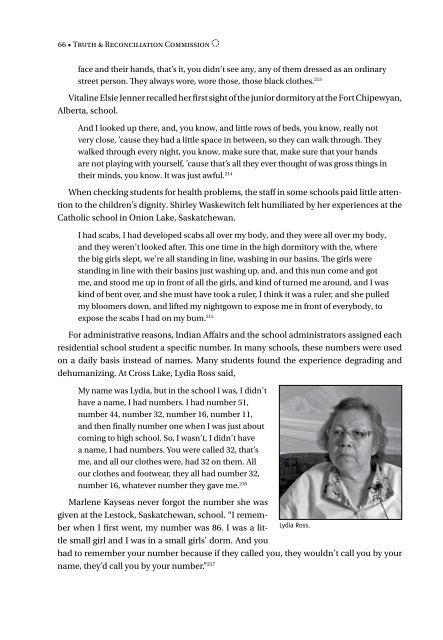The Survivors Speak
1MB8J05
1MB8J05
You also want an ePaper? Increase the reach of your titles
YUMPU automatically turns print PDFs into web optimized ePapers that Google loves.
66 • Truth & Reconciliation Commission<br />
face and their hands, that’s it, you didn’t see any, any of them dressed as an ordinary<br />
street person. <strong>The</strong>y always wore, wore those, those black clothes. 213<br />
Vitaline Elsie Jenner recalled her first sight of the junior dormitory at the Fort Chipewyan,<br />
Alberta, school.<br />
And I looked up there, and, you know, and little rows of beds, you know, really not<br />
very close, ’cause they had a little space in between, so they can walk through. <strong>The</strong>y<br />
walked through every night, you know, make sure that, make sure that your hands<br />
are not playing with yourself, ’cause that’s all they ever thought of was gross things in<br />
their minds, you know. It was just awful. 214<br />
When checking students for health problems, the staff in some schools paid little attention<br />
to the children’s dignity. Shirley Waskewitch felt humiliated by her experiences at the<br />
Catholic school in Onion Lake, Saskatchewan.<br />
I had scabs, I had developed scabs all over my body, and they were all over my body,<br />
and they weren’t looked after. This one time in the high dormitory with the, where<br />
the big girls slept, we’re all standing in line, washing in our basins. <strong>The</strong> girls were<br />
standing in line with their basins just washing up, and, and this nun come and got<br />
me, and stood me up in front of all the girls, and kind of turned me around, and I was<br />
kind of bent over, and she must have took a ruler, I think it was a ruler, and she pulled<br />
my bloomers down, and lifted my nightgown to expose me in front of everybody, to<br />
expose the scabs I had on my bum. 215<br />
For administrative reasons, Indian Affairs and the school administrators assigned each<br />
residential school student a specific number. In many schools, these numbers were used<br />
on a daily basis instead of names. Many students found the experience degrading and<br />
dehumanizing. At Cross Lake, Lydia Ross said,<br />
My name was Lydia, but in the school I was, I didn’t<br />
have a name, I had numbers. I had number 51,<br />
number 44, number 32, number 16, number 11,<br />
and then finally number one when I was just about<br />
coming to high school. So, I wasn’t, I didn’t have<br />
a name, I had numbers. You were called 32, that’s<br />
me, and all our clothes were, had 32 on them. All<br />
our clothes and footwear, they all had number 32,<br />
number 16, whatever number they gave me. 216<br />
Marlene Kayseas never forgot the number she was<br />
given at the Lestock, Saskatchewan, school. “I remember<br />
when I first went, my number was 86. I was a little<br />
small girl and I was in a small girls’ dorm. And you<br />
Lydia Ross.<br />
had to remember your number because if they called you, they wouldn’t call you by your<br />
name, they’d call you by your number.” 217


